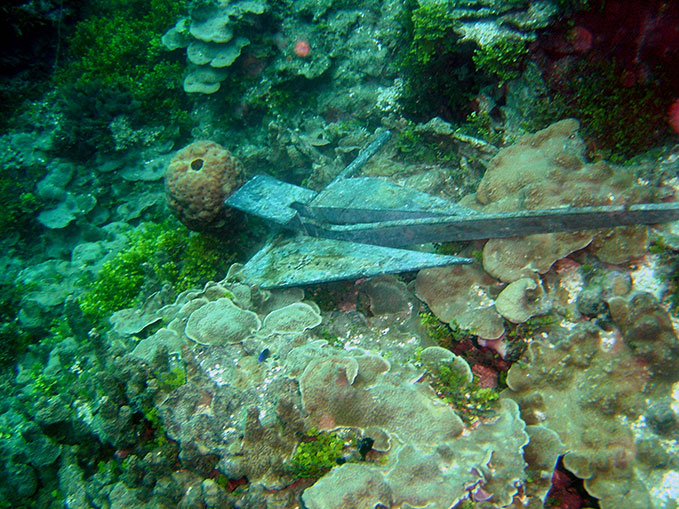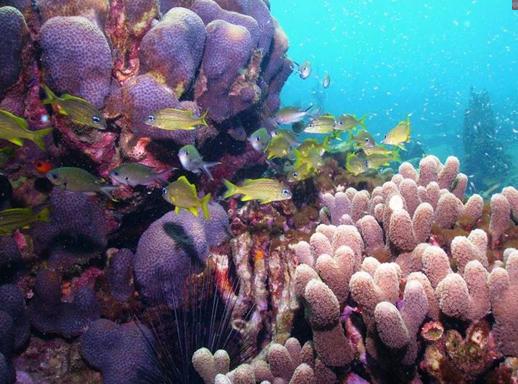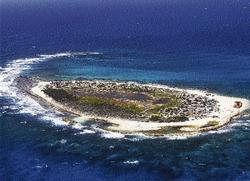REEF FISHERIES & BIODIVERSITY
Management and Conservation of Reef Biodiversity and Reef Fisheries
Introduction
Coral reefs in the region are essential to the fisheries and tourism sectors. The economies of many countries within the region depend on coral reefs. It is estimated that in the Bahamas, marine resources contribute US $2.7billion through tourism and the harvest of marine resources.
Reef Biodiversity and Reef Fisheries” is one of two Pilot Projects implemented as part of the CLME Project
However, the future of reef fisheries and coastal tourism is heavily dependent on the health of coral reefs and associated ecosystems such as mangrove forests and sea grass beds. Many of these ecosystems are currently under threat in the Region, as a result of unplanned and unregulated coastal zone development. Warming sea temperatures are also having negative impacts on coral reef ecosystems. In 2005 and 2010, widespread bleaching events associated with high coral mortality were experienced along many coral reefs in the region, a result of very intensive El Ninos. With the anticipated impacts from climate change expected to be more intense, it is expected that many of these incidences will become a lot more frequent.
Many reef fisheries in the Caribbean are overexploited, a consequence of unsustainable fishing practices. Overfishing not only reduces the amount and size of species harvested, but can also lead to shifts in reef community structure, which may seriously affect overall ecosystem health.
Unlike other fisheries in the region which are clearly more transboundary in nature and have established sub-regional and regional management frameworks, management of the reef fisheries occurs primarily at the local and national level. In many instances, the Fisheries Departments are charged with the mandate of managing the fishery, whilst the responsibility for managing the ecosystems lies
The EBM approach applied under the pilot project seeks to address three key problems:
Habitat degradation and community modification
Unsustainable exploitation of resources
Pollution
with other governmental agencies, such as Ministries of Environment.
Traditional sectoral approaches to fisheries management have proved unsuccessful in ensuring effective management and conservation of marine and coastal resources. The project therefore seeks to adopt an innovative approach to Reef Biodiversity & Fisheries management, by promoting the implementation of Ecosystem-Based Management (EBM) of living marine resources.
To a large extent, effectively improving management involves changing the behavior of people. For this reason, this pilot project is promoting participatory management approaches that communities and local governments can adopt to ensure more effective management of coral reefs and associated ecosystems.
Part of the Ecosystem-Based Management approach being promoted under this pilot project consists of encouraging greater stakeholder participation.

Careless anchoring adds to stress on otherwise healthy coral reef. Photo by David Burdick, at NOAA's Coral Kingdom Collection
Three pilot sites in Colombia, Jamaica and the Dominican Republic have been identified to test the implementation of the management approaches promoted under this pilot project. Lessons learnt and best practices from these pilots would then be upscaled and included in the Strategic Action Programme for replication in other coastal communities within the CLME.
Implementing an Ecosystem-Based approach to Reef Fisheries & Biodiversity management requires the coordination of actions between a number of sectors including:
environment
development
fisheries
tourism

Goals
Develop/enhance integrated and cost-effective strategies to mitigate impacts from overfishing and inappropriate coastal development, focusing primarily on regulatory frameworks, restoration of deteriorated coastal areas and habitats with an emphasis on reef systems and their fisheries resources and increase in habitat and biodiversity knowledge of remote reefs.Objectives
To promote the ecosystem-based approach for the conservation and effective management of coral reef ecosystems and their associated resources in order to maintain their functional and structural integrity and biodiversity, and to ensure economic and social benefits for local communities and the region as a whole. OBJECTIVE To promote the ecosystem –based approach for the conservation and effective management of coral reefs and their associatedGeographic Scope
The approaches outlined under this project will be tested within three important coral reef systems:

The Pedro Bank is a large bank approximately 80km south and south-west of Jamaica, rising steeply from a sea-bed of 800 metres depth. The Bank is composed of a number of marine habitats including sand banks, coral reeds, deep water reefs, sea grass beds and three coral cays known as the Pedro Cays. The Pedro Bank represents Jamaica’s main commercial and artisanal fishing grounds and serves as the primary site for the island’s important Queen Conch fishery. With an estimated 99% of mainland Jamaica’s coral reefs being threatened, the coral reeds on Pedro bank are vital to the long-term reef conservation in the country.
The Monti Cristi National Park (Parque National Monte Cristi) is located in the northwest coastal lowlands of the Dominican Republic very close to Haitian border. It extends from the borders of Haiti to Punta Rucia in the Dominican Republic and covers an area of 550 km² and consists of coastal lagoons, beaches, mangrove swamps a 237 m limestone mesa from which one can see offshore keys and forested slopes. The area is very dry receiving approximately 2 inches of rain per year.
Caracol Bay
is situated along the north eastern coast of Haiti, in relatively close proximity to the Monti Cristi National Park. The area contains a large expanse of mangroves, as well as a fringing coral reef. There are also a number of fishing communities which depend on the marine habitats within the Bay for their livelihoods. A study in 2009 estimated the ecosystem services for Caracol Bay to be for mangroves US $105,228,000 and US $4, 505,000.
Project Components
The following are the five (5) project components under this case study:
-Component 1 – Integrated ecosystem based management needs assessed and strengthened management frameworks.
-Component 2 – Review and analyze existing management regulations and enforcement mechanisms at selected sites.
-Component 3 – Public awareness and education outreach enhancement.
-Component 4 – Better practices and lessons learnt disseminated.
-Component 5 – Adaptive Management and Best Management Practices.
Expected Outcomes
-To contribute towards the sustainable use of reef fisheries and marine biodiversity through the application of the ecosystem based-approach and on the basis of the principles and values of good governance.
-To strengthen or improve the governance of reef fisheries and marine biodiversity management at the local, national, and regional levels through improved, regulation enforcement and community involvement in large reef systems with demonstrable cross-cutting multi-sectoral linkages.
-To enhance marine biodiversity conservation through the strengthening of existing marine protected areas to enable them to meet their conservation objectives,
-To facilitate the transfer of best practices and dissemination of lessons learnt on technical aspects and governance systems; and
-To promote the ratification of international agreements relevant to the sustainable use of coastal and marine resources in the CLME.

POSTAL ADDRESS: Edificio Chambacú - Oficina 405, Cra 13B# 26-78, Cartagena de Indias, Bolívar, Colombia
EMAIL: info@clmeproject.org

